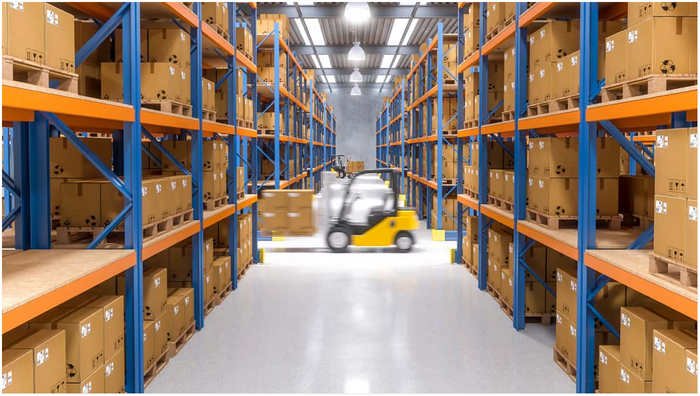Flexible Fulfillment Solutions & Benefits for Your Business

“Fulfillment” refers to processing, packaging, and shipping orders for goods. Fulfillment is usually a service offered by companies that sell products online.
This guide will review the different fulfillment options available to e-commerce businesses and show how they can help grow your business. We’ll explain how you can combine these options to get a package perfect for your needs.
After placing an order for the item, a customer’s online buying experience is often the most apprehensive. Although customers know what they request, they are frequently unsure what will be packaged and delivered to their doorstep. By being well-prepared in terms of inventory and logistics management, flexible fulfillment services aim to put an end to that tension.
What Is Flexible Fulfillment?

A flexible fulfillment approach can grow or shrink to accommodate shifting demand levels. The capacity to complete several order types through a single network, including small packages, freight, and white glove, is another characteristic of flexible fulfillment. These services are flexible and safe and provide various items.
Three key traits of flexible fulfillment models enable businesses to swiftly adapt to changing company demands and boost profitability by lowering fulfillment and delivery costs.
- Asset-light
- On-demand
- Technology-first
We’ll go through how each attribute supports flexible company models that can swiftly change directions and risk-free enter new channels and markets.
What are the Benefits of a Flexible Fulfillment Solution for Your Business?
There are numerous advantages to using flexible fulfillment solutions, and we will discuss the top three benefits mentioned below.
- Increased Efficiency and Cost Savings
They can significantly improve efficiency and reduce costs. Businesses can streamline inventory management, order processing, and using a third-party fulfillment provider. It can help to eliminate wasted time and resources, resulting in a more cost-effective operation. Additionally, it is easier to scale according to demand, allowing businesses to adjust quickly to changes in the market.
- Improved Customer Service and Satisfaction
A flexible fulfillment provider can also help businesses improve their customer service. Companies can rely on a third-party provider to ensure that orders are delivered quickly and accurately. It can help build customer loyalty, as customers are more likely to return to a business that delivers their orders on time and accurately. Additionally, businesses can free up their staff to focus on providing excellent customer service.
- Improved Customer Service and Satisfaction
A flexible fulfillment provider can also help businesses improve their customer service. Companies can rely on a third-party provider to ensure that orders are delivered quickly and accurately. It can help build customer loyalty, as customers are more likely to return to a business that delivers their orders on time and accurately. Additionally, businesses can free up their staff to focus on providing excellent customer service.
Why Are Flexible Order Fulfillment Services Important for Any Business?
The difficulty of flexibility in order fulfillment is that retail businesses now need to enhance their inventory ways. Items should be easy for staff to discover and prepare, much like in a formal warehouse. If done successfully, there might be a vast reward. However, that depends on strategy and technology.
Why Keeping Good Relations with Retailers:

Outside your platform, your retailer is your conduit to the consumer. This connection is significantly impacted by poor logistical management. However, flexible fulfillment enables firms to increase sales by using their resources better and minimizing the need for closeout or discount products.
- Managing Sudden Demand:
Today’s consumers are erratic in their brand loyalty. You never know when a given product can become unexpectedly popular because of the impact of social media and celebrities. Who might be better equipped to deal with the increase in sales by having a flexible fulfillment plan?
- Managing Sales Growth:
By ensuring that it has the inventory on hand to meet demand, flexible fulfillment enables businesses to satisfy the shipping requirements of their clients. When your inventory database is linked, your company may access it from any location to control sales and foster expansion.
The Best Flexible Order Fulfillment Companies Have These Features:

It would help if you searched for specific characteristics in your order fulfillment providers. I’ll list a few:
- Active Listening:
They must be receptive to hearing opportunities and worries from every link in the logistical chain.
- Learning:
There is always more to learn. Your partners should be able to modify and enhance your company’s offerings based on what they have discovered from their own experiences and by working with you specifically.
- Open-Minded:
You have the right partner who can focus on creating and implementing a strategic framework while also giving opportunities for creativity.
- A Collaborative approach:
It’s crucial to remember that the customer is also involved in this process. For people to feel confident in the service, there must be openness. Additionally, logistics comprises numerous stages of activity, all of which must function well in concert if your company is to fulfill its customer commitments.
Use a Flexible Fulfillment Strategy to Reduce Warehouse Costs

1. Managing inbound and outbound freight:
Virtual libraries have great articles on how to cut costs or slow them down. Preventing earnings erosion must be your top priority constantly. Use a consultant to assist you in submitting a competitive offer. Even if carrier agreements are confidential, knowledgeable consultants can point out areas where they can cut services without sacrificing savings.
2. Incentive Pay:
It’s easy to see why so many companies have been instituting achievement-based pay systems. Some data suggest that this can significantly increase worker productivity. You must constantly be careful to avoid paying for products you already receive or may obtain in other ways. Pick and pack make up more than 50% of your warehouse labor, so start there.
3. Simplify Procedures, Cut Costs, and Touches:
Do order and product flow cross the floor and no longer make sense? Have you layered new functionalities onto more enduring old ones throughout the years? Take a fresh look at the physical procedures and actions necessary for order fulfillment and product movement. In general, fewer touches with fewer steps equals cheaper expenses
4. If you haven’t measured it, you can’t improve it:
Does your business track and manage important KPIs? Do you clearly understand your essential productivity and shipping expenses, including the price per box and line shipped? Even though my firm had a $25 million revenue, they couldn’t disclose these crucial figures. How can we evaluate and implement cost-reduction strategies if we don’t know the starting point? What do different kinds of mistakes cost? How much return?
Once these elements are in place, create frequent employee feedback on departmental and individual performance. You’ll be more productive because of their response.
5. Create More Effective Frontline Managers:
Successful managers understand that execution is everything. Your expenses, employee morale, and the caliber of client order fulfillment are all significantly impacted by their capacity to handle every component of satisfaction effectively. What are each person’s specific needs? What additional exposure to your firm will give them a better understanding of your products, clients, and suppliers? What local or online training resources are offered?
6. Chain of inbound supplies:
To effectively manage the receiving dock and yard, changes to the supply chain include timing incoming purchase orders. Create vendor compliance policies that cover the terms and circumstances of the sale, the deadline for delivery, the quality and item specifications, the routing and importing instructions, the product labeling, and packing requirements, and drop-ship vendor requirements. Provide vendors with high-quality, value-added services, so the product is ready to be stored or sent. It lowers the labor required to fix errors.
7. Technology that enables voice:
For better inventory management and higher efficiency, voice enabling may be used in various operations and departments, from receiving to shipping and returns. These solutions don’t need substantial training, install rapidly, don’t need IT support, and offer a quick return on investment (ROI) of four to six months. However, do your research since not all voice apps are made equally. Several providers cut their prices to make this technology accessible to companies of all sizes.
8. Third-Party Logistics to Think About:
Not everyone should use a third-party logistics service (3PL). Many of our customers think they can complete fulfillment more cheaply and effectively on their own. However, we have observed positive results from 3PL at prices comparable to internal costs. Investing in new facilities and systems is avoided by working with a 3PL partner. For smaller businesses, 3PL enables management to focus on the marketing and merchandising tasks necessary to maintain development. Consider 3PL as a solution if you need to expand warehousing, storage, or order throughput.
9. Licensed On-Premises Systems vs. SaaS:
Due to the cost and length of the deployment process, businesses only invest in new enterprise-wide, WMS, or order management systems every 5 to 10 years. A less expensive option for purchasing a new system is a SaaS subscription model. It is true and something to keep in mind when considering whether to buy software on a subscription basis. However, over a more extended time, the sum you pay could be significantly less than what it would cost to purchase new software outright. Compare the specifics of SaaS WMS’s warehousing functionality as well. Generally speaking, more efficient warehouse operations may save costs and enhance service.
Continuous Improvement Process:
Successful entrepreneurs and marketers track everything and analyze the outcomes of their campaigns. Make an evaluation. Create a plan. Establish goals, hold people accountable for improvement, assess your progress and start over.
Three Ways to Achieve Flexible Fulfillment

- Co-warehousing
According to McKinsey, flexible options like co-warehousing enable small to mid-sized merchants to share warehousing space and labor costs, making more advanced fulfillment capabilities attainable for businesses of all sizes.
Sharing space and labor allows merchants to distribute inventory across multiple warehouses – forward stocking their products closer to the end customers, which lowers time in transit (TNT) on final mile deliveries. Lower TNT results in faster, more affordable fulfillment that meets consumer expectations.
- On-demand fulfillment
On-demand warehousing and fulfillment is an asset-light solution that allows you to only pay for the space and labor you need when you need it. An asset-light answer is essential to flexible fulfillment, enabling you to take full advantage of seasonal or cyclical demand patterns.
With an asset-heavy fulfillment model, merchants are constantly torn between paying for high-demand periods and being left with excess stock during lower-demand periods or scaling down production and missing opportunities.
On-demand fulfillment offers a third option fully responsive to market and business needs. The United States fastest-growing helmet brand, LS2, found that traditional fulfillment models were too capital-intensive to support their rapid growth. They found an on-demand fulfillment partner that allowed them to grow into new markets without raising additional capital expenditures.
- Technology-first solutions
Supply chain technology has evolved better to serve increasingly flexible and scalable digital sales channels. It has never been easier to launch online sales. eCommerce shopping carts, third-party marketplaces, and social selling give merchants and consumers endless opportunities to buy and sell digitally.
The flexibility of eCommerce platforms enables them to be turned on or off based on product availability, demand, or profitability. We have a complete solution for everything. You can find your favorite media in one place, which lets you manage and monitor many things from one dashboard. However, launching or growing a sales channel without having a flexible fulfillment solution to meet eCommerce shipping expectations will ultimately lead to a frustrating customer experience. Technology-first fulfillment enables merchants to integrate their sales channels with their supply for complete flexibility.